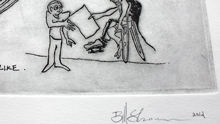TShirts, Stickers, Prints, Art Objects
WhatIsWhat 1.0 2003
Shannon Technique : The Sweeper-Spin
ABOVE: A video of The Sweeper-Spin (starts at :09) edited to show progression from Standard Sweeper. ( see Introduction to Shannon Technique for context ) The move reflects technical progression by way of physical limitation. For more writing about this lopsided progression of my dance Clik " read more" below.
I originally classified the Sweeper upon its creation and naming with other traveling moves that covered ground quickly such as No-Footers, Glides, Uprocks and Big Swings. The Sweeper later was extended and refined and led to combos such as the Sweeper Kick-Out, Sweeper-Kickout Crossed-Up Heel-Hold No-Handed Rotation, Finger-Flip Sweeper, Sweeper to Dogleg, Sweeper Toe-Stall and others. The Sweeper-Spin is yet another progression from the Sweeper . While writing this post it occurs to me that the Sweeper is in a different category than how I originally classified it as a simple travel move. I now think of the Sweeper as more of a critical setup move or a foundation move from which many others movements and combos may occur.
The Sweeper-Spin specifically was an accidental progression from the standard Sweeper and first occurred while I was attempting Shannon Technique movements in reverse. The critical difference between the standard Sweeper and the Sweeper-Spin is in the way the follow leg ( right leg in the video ) is pulled into the center of the motion as opposed to extending outward behind as in the standard Sweeper or threaded thru as in the Sweeper Kick-Out. The other difference in the Sweeper-Spin is the manner in which the sweeping crutch guided by the left leg contacts the centered crutch with a signature clik-clak then slides up the lo-bars as the spin progresses. In the video, the first several Sweepers make the crutch to crutch contact but I do not tuck in my follow leg. The final example shown in the video above reveals how the leg is tucked into the spin. The difference in the speed and quality of rotation is apparent when the right leg is tucked in. It is only when the follow leg is tucked and the spinning force is compressed that the move differentiates itself from a standard Sweeper.
It is no accident that it is the right leg tucking in. The right leg is to weak to hold a spin and remain extended so it naturally pulls in. The dramatic difference in strength, and the difference in pain-to-motion ratio from my left to my right leg, has always caused Shannon Technique to be heavily one-sided in favor of my left leg as the weight bearing and impact taking leg. The compensation for the weaker right leg has always put the right in the more aerial or less weight bearing position on any given move. However with the Sweeper-Spin, as I mentioned earlier, following trends in skateboarding I began trying all of my moves forward and backward and left and right. Some very interesting discoveries of differences in the moves based on the redistribution of strong and weak leg switching roles occurred when I made this conscious decision to diversify away from my safety zone. The Sweepers in this video put more pressure into my right hip and are less natural for me to perform given the instinct to protect my right. If you step thru the frames you can see how I use the right leg to bear full weight for a split second during the setup whereas normally I would defer to the left taking this push-off weight. Also on the follow thru after the move comes down I land with the right whereas it is customary to land on my left. In this video I edited the move to show progression from shorter to longer lo-bar contact and hang-times and have only included the successful follow-thrus to freeze. I have caught 720's but never landed them because they would fall apart or tilt over to far to save. I have also caught 540s and landed them but not on video… yet ( ad that to the list ).
So, that is the short version of the Sweeper-Spin story. I truly enjoy sharing my stories and details behind the dance and even behind a single move. I think the role of disability in defining the aesthetics of Shannon Technique has largely been understood through the icon of the crutches. The truth of the dance and my story is that it has been the creative efforts of working within the limitation of the body, the pain, the lack of range and flexibility, the lack of sustainability over time, the gut level and psychological fear of commiting greater damage while taking risks that has really shaped the internal workings of the dance an dhow it is performed. These physical factors have shaped Shannon Technique on an equal if not greater footing than the actual use and manipulation of the crutches. Still, the innovations of the dance thorugh the disabled body are executed to the utmost detail while remaining in the shadow of the sociological implications, innovations and manipulations of the icon of my disability, the crutches. SO be it. I keep dancing.

This Work, Shannon Technique : The Sweeper-Spin , by williamfshannon@gmail.com is licensed under a CC BY-NC-SA license.
